Mal, yes Del: a real look at the Japanese project Minimal Fab
On May 16, the traditional seminar-meeting with Japanese developers and manufacturers of a compact technological line, the so-called Minimal Fab, was held at MIET (Zelenograd).

The previous big seminar was held there in 2017, and there is an almost three-hour recording on youtube. I have long wanted to write a great note on this topic, collected a lot of material, and after this meeting I finally “matured”. Still, a lively meeting with questions and answers is much more effective than the study of articles. In addition, recently there have been several articles where this line is illuminated one-sidedly, in some admiring and not quite adequate way of “admiration”. Let's understand ...
The main ideologist of the Minimal Fab project is the Japanese scientist Shiro Hara. In the mid-2000s, he proposed a radical approach to reduce the cost of semiconductor manufacturing - to go down the path of reducing equipment and the diameter of the original plates.
In 2010, a consortium was created with the support of the Government of Japan and under the auspices of the National Institute of Advanced Industrial Science and Technology (AIST) to implement this idea . This consortium includes more than a hundred Japanese companies engaged in the development of materials, equipment and technology.
In 2017, a separate organization was allocated to promote Minimal Fab as a ready-made solution to the semiconductor market (Tokyo Boeki Group Ltd).
')
This idea of diminishing goes against the current global trend. If you look at the modern evolution of semiconductor production, then simultaneously with a decrease in the minimum size there is an increase in the diameter of the plates and an increase in the productivity of equipment. This leads to the fact that several leading companies today, such as TSMC, Intel, Samsung, can pull the creation of modern mass production. These are owners of the so-called MegaFabs, in terms of the concept.
They "hold" more than half of the total market volume, possessing significant production capacity for the production of mass IS. Small producers are “washed out” from the market, unable to compete in price with giants in the consumer sector. Or go to the specific niche of unique products, with a large margin, but with small volumes. At the same time, small companies are in an unstable position, as they are forced to follow the global trend of “giantomania” and invest heavily in infrastructure and equipment. Conventionally, if I want to build a line for a small volume today, and the old level of technology (~ 3 microns), then I will have to spend more than it was thirty years ago in equivalent prices. Such is the paradox.
What do those who want to buy a small series of IP? You can go to the same giant companies and order a “shuttle” from them, within the framework of the MWP. It will not be very cheap and not too fast (production cycle 1-2 months per CMOS technology 28nm). But if something specific is needed in terms of technology, then there will be a problem. Development of technology is very expensive, and no one will do it to fulfill an order, for example, for ten plates. It would be nice to have your ticker, but not expensive.)
The author of the concept of Minimal Fab proposed to significantly reduce the cost of "entrance ticket" in the production of semiconductors. This is achieved by the following decisions:
- reduction of the plate diameter from the modern standard of 300mm (plate area ~ 70650mm2) to a diameter of 12.5mm (plate area ~ 122mm2). This area is enough to accommodate one large scheme or several small ones. The plates are made by cutting from large plates with additional processing (photo of a plate placed in a cassette):
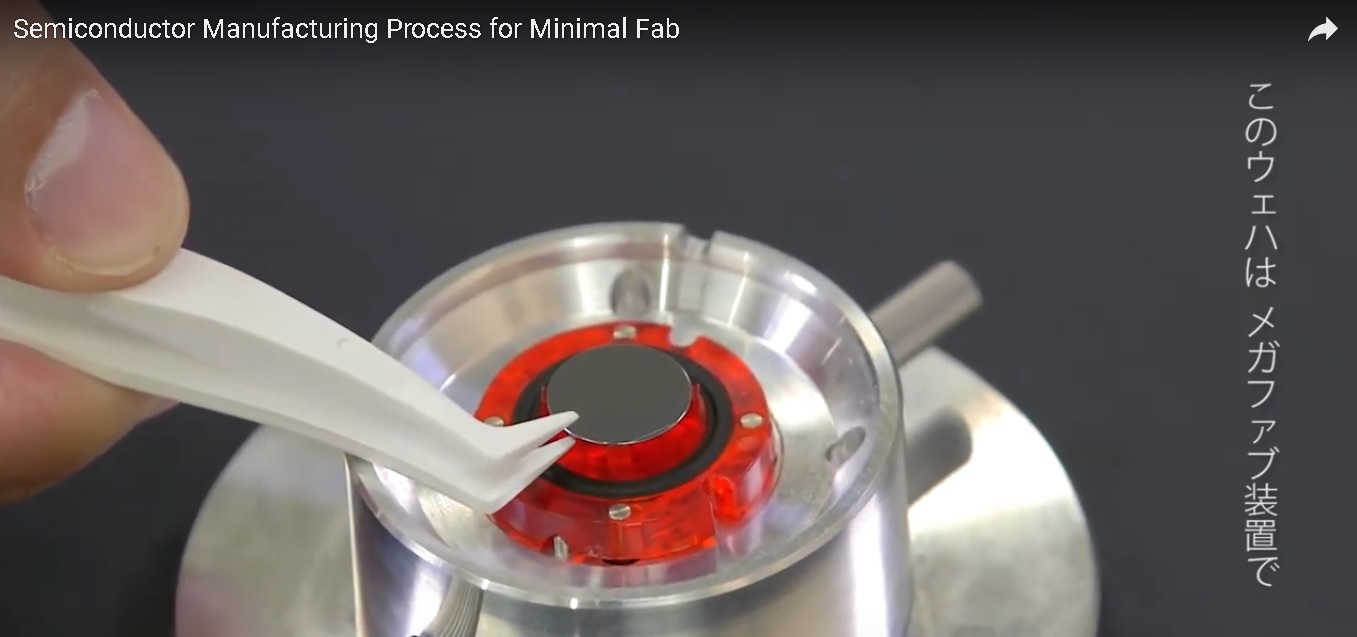
- the plate is in a capsule isolated from the external environment (a certain analogue of SMIF), which opens only inside the unit. Only one plate is processed in one process.
(the container with the plate inside is loaded into the unit)

- all equipment is performed in a unified form factor (dimensions 1440x300x450mm), without the procedure of complex start-up and connection. Each unit performs one type of process (chemical treatment, pickling, etc.).
The interface and control of installations is standardized.
No infrastructure required in the familiar MegaFactory format. Gases and reagents are located inside installations in compact cartridges (tanks), gases in cylinders. Exhaust required to remove gaseous reaction products and heat sink:
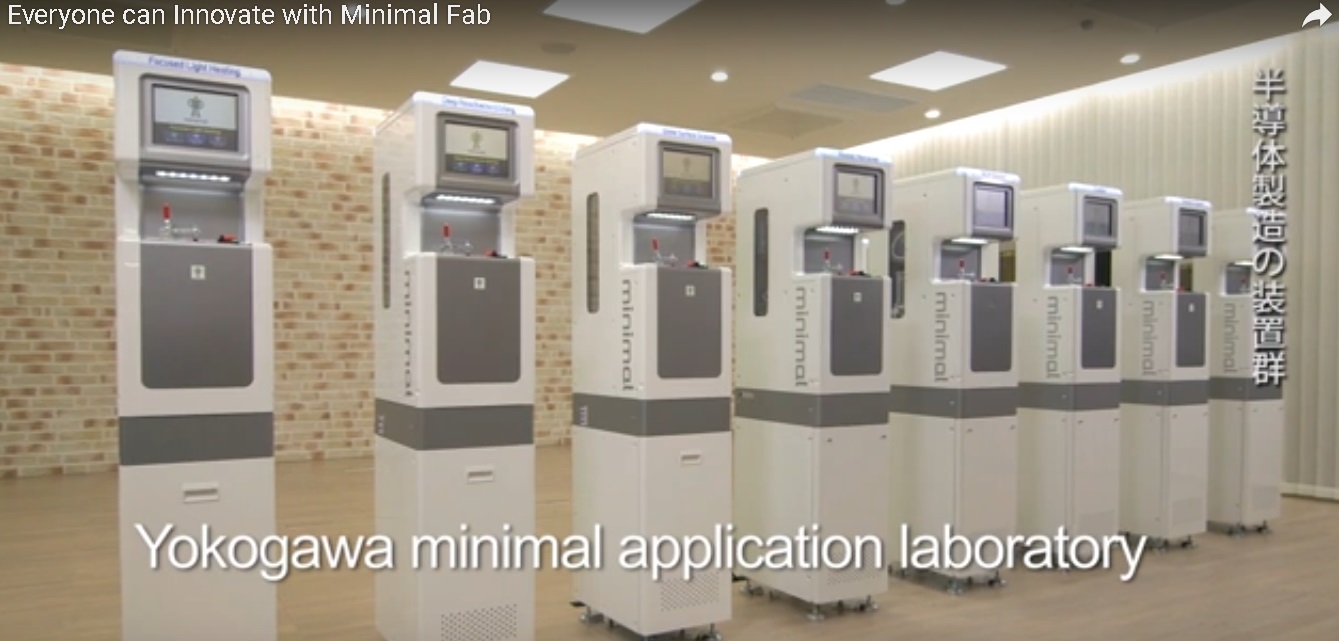
- it is declared that it does not require a clean room indoors, since the processing zone of the plate is isolated from the environment. Inside the processing zone of the plate, due to tightness, an ISO 4 cleanliness class is achieved (with an external cleanliness class of ISO 9, an ordinary office).
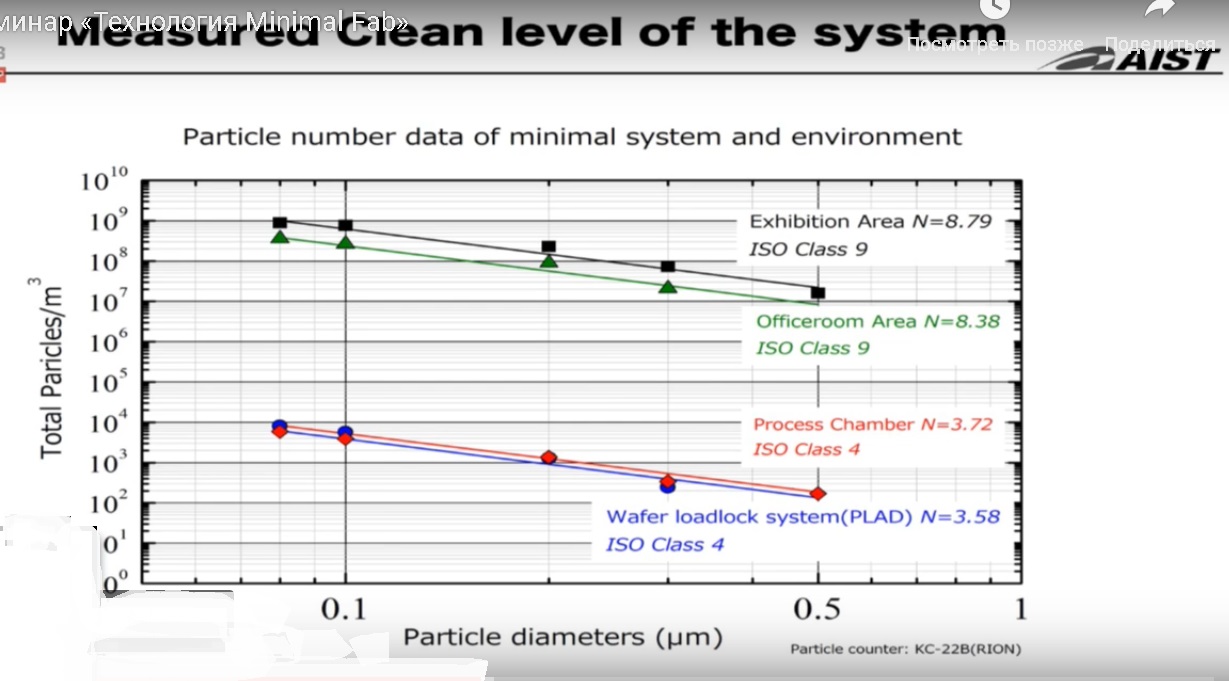
- bezmashochny (without photogame) method of forming a pattern on the plate. The image is formed by direct projection onto a photoresist (classical application and development). The wavelength of 365nm, the estimated resolution of the system 0.5mkm. The marginal zone is about 0.5 mm (the working diameter of the plate will be about 11 mm).
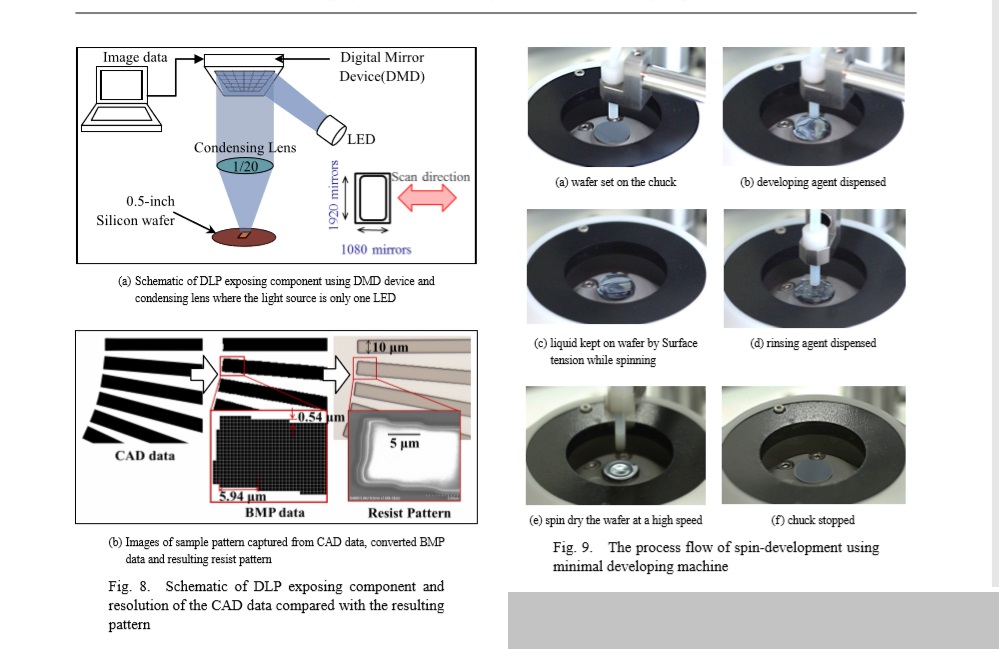

The obvious advantages of this concept:
The authors of the concept even cite the following assessment comparing MegaFab and Minimal Fab:

Very effective comparison. It is especially to the liking of those who insist that Minimal Fab replace a full-fledged factory, and this is the best and only way. Well, here, there are billions, and here are millions.
But it is here that the collision of the concept with reality begins.
At present, the level of implemented CMOS chips on the Minimal Fab lineup is not too impressive. Made quite simple samples of the type of NAND-cells and ring oscillators, consisting of 400 transistors. The shutter size is a few microns, the technology is quite primitive (the level of the late 70s, early 80s). On a photo the samples presented in 2018 on SEMI Japan.

As well as a slide from the presentation, which shows a schematic route for making samples in 2013. The route consists of 39 operations, pn transitions from a diffusion source, one wiring layer ...
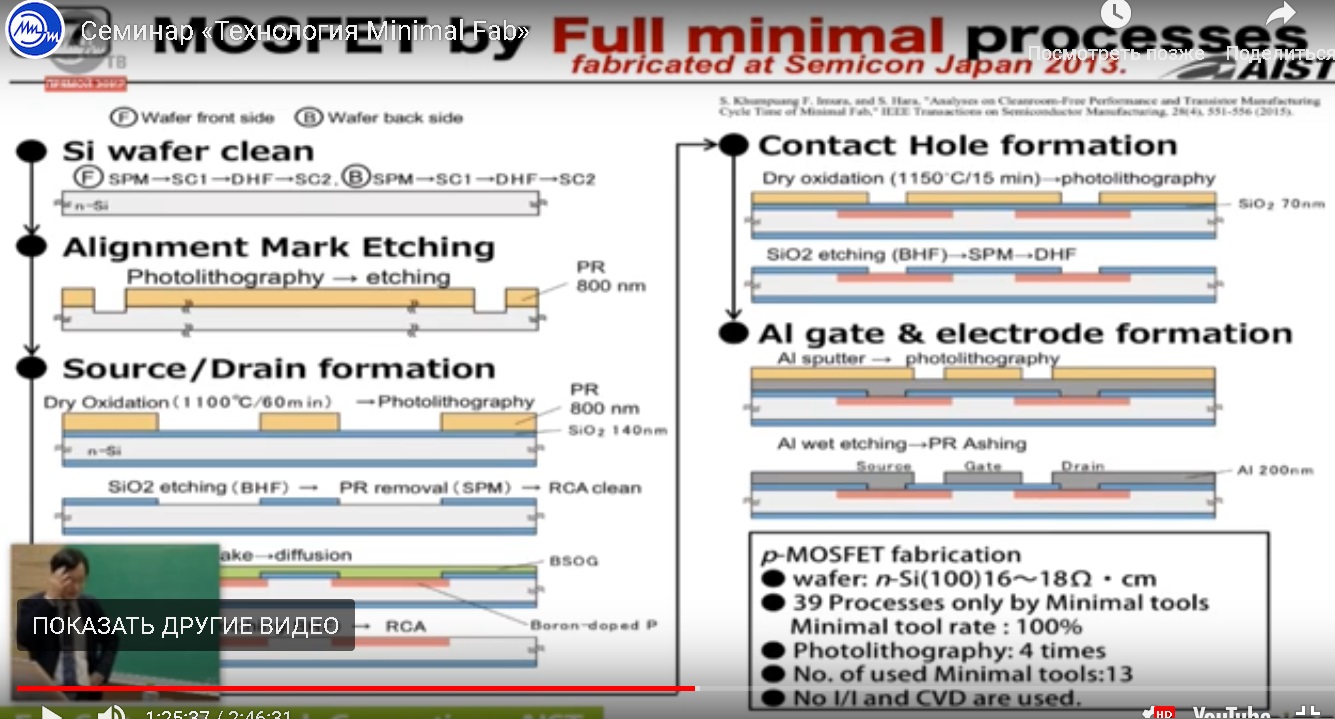
Ion doping processes are not currently implemented in the Miimal-Fab form factor, although the work is underway. So far, the promised energy is up to 60 keV, and two types of elements, B and P. It is not clear how to achieve high energies in order to achieve a limited size of installations. As an option - a hybrid implementation (to make processes on ordinary equipment, at the expense of special holders).
Realizations of at least two-layer cabling to talk about the level of 1-0.8 μm are also not yet visible. Not all PCT processes are implemented.
The level of photolithography, achieved today by developers, is named up to 0.5 microns. It is said that it seems to be a step, but some materials are not shown. Further plans are to switch to electron-beam lithography, but this is in perspective.
This is how the roadmap looks like:

So far, a comparison of a full-fledged factory worth five billion and the current Minimal Fab line looks somewhat deceptive. And those who appeal to this, do so either out of ignorance, or vice versa, because of too much knowledge.
The developer of the concept itself does not oppose itself to TSMC, for example.
Niche application authors Miniaml Fab seems. The figure shows the analysis of US semiconductor manufacturers (slide from the presentation of 2017).

Approximately 98 factories in the United States are engaged in the manufacture of semiconductors in the range of technical process from 0.5 microns and more, the diameter of the plates from 100 and below. These are producers of medium and small volume, most often. These are all types (CMOS, MEMS, discrete) In terms of technology, this already roughly corresponds to the capabilities of the Minimal Fab line, with the current level f / l (even without an electron beam). There is a hardware problem for the specified factories. New equipment for such a diameter is not available, and here the Minimal Fab format is very suitable. According to the developers, to replace these capacities, thousands of Minimal Fab lines are required.
In principle, a similar situation, but on a smaller scale, exists in our country. We also have enough of the old lines, which make small volumes according to the technology of the king of peas (various shaggy series of ten transistors for horse standards, etc.).
The second interesting and really relevant niche is specific technologies.
SOI, MEMS, sensors, hybrid circuits (CMOS + sensor, bolometer type) discrete, microwave, Backend operations like bumping, A3B5 connections ... All this is done on a small diameter, as a rule, in small volumes. And here Minimal Fab wins the traditional implementation (in the photo an example of the implementation of the MEMS structure).

Today it has been announced that already 5-6 lines of Minimal Fab work as functioning in full-fledged mode for customers. A representative of one of the companies spoke at the seminar, who spoke about his experience of application.
Characteristically, they use Minimal Fab equipment in a hybrid format. That is, they have a traditional clean room with equipment for the Backend process (something like an interposer for bumping). And several units of Minimal Fab implement the processes f \ l and chemical processing.
We have an idea MinimalFab consistently promotes MIET. Conducts seminars and meetings with technology developers (at the meeting, after the conference, an agreement was signed between NIU MIET, Tokyo Boeki (RUS) LLC (with 100% Japanese capital) and the Association of universities that train personnel in the radio-electronic industry).
There is a Russian-language site of the company Tokyo BOEKI Rus.
A couple of years ago, ADGEX company very pompously announced “the beginning of a new era in the world of microelectronics,” and threatened to start supplying “devices” manufactured at Minimal Fab from 2018, but something went wrong.
As an option in the hybrid mode (Minimal Fab in a classic factory).

The previous big seminar was held there in 2017, and there is an almost three-hour recording on youtube. I have long wanted to write a great note on this topic, collected a lot of material, and after this meeting I finally “matured”. Still, a lively meeting with questions and answers is much more effective than the study of articles. In addition, recently there have been several articles where this line is illuminated one-sidedly, in some admiring and not quite adequate way of “admiration”. Let's understand ...
Reduction concept
The main ideologist of the Minimal Fab project is the Japanese scientist Shiro Hara. In the mid-2000s, he proposed a radical approach to reduce the cost of semiconductor manufacturing - to go down the path of reducing equipment and the diameter of the original plates.
In 2010, a consortium was created with the support of the Government of Japan and under the auspices of the National Institute of Advanced Industrial Science and Technology (AIST) to implement this idea . This consortium includes more than a hundred Japanese companies engaged in the development of materials, equipment and technology.
In 2017, a separate organization was allocated to promote Minimal Fab as a ready-made solution to the semiconductor market (Tokyo Boeki Group Ltd).
')
This idea of diminishing goes against the current global trend. If you look at the modern evolution of semiconductor production, then simultaneously with a decrease in the minimum size there is an increase in the diameter of the plates and an increase in the productivity of equipment. This leads to the fact that several leading companies today, such as TSMC, Intel, Samsung, can pull the creation of modern mass production. These are owners of the so-called MegaFabs, in terms of the concept.
They "hold" more than half of the total market volume, possessing significant production capacity for the production of mass IS. Small producers are “washed out” from the market, unable to compete in price with giants in the consumer sector. Or go to the specific niche of unique products, with a large margin, but with small volumes. At the same time, small companies are in an unstable position, as they are forced to follow the global trend of “giantomania” and invest heavily in infrastructure and equipment. Conventionally, if I want to build a line for a small volume today, and the old level of technology (~ 3 microns), then I will have to spend more than it was thirty years ago in equivalent prices. Such is the paradox.
What do those who want to buy a small series of IP? You can go to the same giant companies and order a “shuttle” from them, within the framework of the MWP. It will not be very cheap and not too fast (production cycle 1-2 months per CMOS technology 28nm). But if something specific is needed in terms of technology, then there will be a problem. Development of technology is very expensive, and no one will do it to fulfill an order, for example, for ten plates. It would be nice to have your ticker, but not expensive.)
The author of the concept of Minimal Fab proposed to significantly reduce the cost of "entrance ticket" in the production of semiconductors. This is achieved by the following decisions:
- reduction of the plate diameter from the modern standard of 300mm (plate area ~ 70650mm2) to a diameter of 12.5mm (plate area ~ 122mm2). This area is enough to accommodate one large scheme or several small ones. The plates are made by cutting from large plates with additional processing (photo of a plate placed in a cassette):

- the plate is in a capsule isolated from the external environment (a certain analogue of SMIF), which opens only inside the unit. Only one plate is processed in one process.
(the container with the plate inside is loaded into the unit)

- all equipment is performed in a unified form factor (dimensions 1440x300x450mm), without the procedure of complex start-up and connection. Each unit performs one type of process (chemical treatment, pickling, etc.).
The interface and control of installations is standardized.
No infrastructure required in the familiar MegaFactory format. Gases and reagents are located inside installations in compact cartridges (tanks), gases in cylinders. Exhaust required to remove gaseous reaction products and heat sink:

- it is declared that it does not require a clean room indoors, since the processing zone of the plate is isolated from the environment. Inside the processing zone of the plate, due to tightness, an ISO 4 cleanliness class is achieved (with an external cleanliness class of ISO 9, an ordinary office).

- bezmashochny (without photogame) method of forming a pattern on the plate. The image is formed by direct projection onto a photoresist (classical application and development). The wavelength of 365nm, the estimated resolution of the system 0.5mkm. The marginal zone is about 0.5 mm (the working diameter of the plate will be about 11 mm).


The obvious advantages of this concept:
- reduction of initial costs for the organization of production by tens or hundreds of times
- no need to build a capital building with supporting infrastructure
- reducing the cost of maintaining the work of such a line by tens or hundreds of times in relation to the usual line (by reducing the consumption of electricity, materials, reducing personnel by standardizing equipment)
- significant acceleration of sample preparation time (from several weeks to days)
- a hybrid variant is possible, when some operations, subject to adaptation, can be performed on standard “large” equipment (IL, ph \ l).
- photomask manufacturing is not required, image correction is possible if necessary
The authors of the concept even cite the following assessment comparing MegaFab and Minimal Fab:

Very effective comparison. It is especially to the liking of those who insist that Minimal Fab replace a full-fledged factory, and this is the best and only way. Well, here, there are billions, and here are millions.
But it is here that the collision of the concept with reality begins.
Reality
At present, the level of implemented CMOS chips on the Minimal Fab lineup is not too impressive. Made quite simple samples of the type of NAND-cells and ring oscillators, consisting of 400 transistors. The shutter size is a few microns, the technology is quite primitive (the level of the late 70s, early 80s). On a photo the samples presented in 2018 on SEMI Japan.

As well as a slide from the presentation, which shows a schematic route for making samples in 2013. The route consists of 39 operations, pn transitions from a diffusion source, one wiring layer ...

Ion doping processes are not currently implemented in the Miimal-Fab form factor, although the work is underway. So far, the promised energy is up to 60 keV, and two types of elements, B and P. It is not clear how to achieve high energies in order to achieve a limited size of installations. As an option - a hybrid implementation (to make processes on ordinary equipment, at the expense of special holders).
Realizations of at least two-layer cabling to talk about the level of 1-0.8 μm are also not yet visible. Not all PCT processes are implemented.
The level of photolithography, achieved today by developers, is named up to 0.5 microns. It is said that it seems to be a step, but some materials are not shown. Further plans are to switch to electron-beam lithography, but this is in perspective.
This is how the roadmap looks like:

So far, a comparison of a full-fledged factory worth five billion and the current Minimal Fab line looks somewhat deceptive. And those who appeal to this, do so either out of ignorance, or vice versa, because of too much knowledge.
The developer of the concept itself does not oppose itself to TSMC, for example.
Niche application authors Miniaml Fab seems. The figure shows the analysis of US semiconductor manufacturers (slide from the presentation of 2017).

Approximately 98 factories in the United States are engaged in the manufacture of semiconductors in the range of technical process from 0.5 microns and more, the diameter of the plates from 100 and below. These are producers of medium and small volume, most often. These are all types (CMOS, MEMS, discrete) In terms of technology, this already roughly corresponds to the capabilities of the Minimal Fab line, with the current level f / l (even without an electron beam). There is a hardware problem for the specified factories. New equipment for such a diameter is not available, and here the Minimal Fab format is very suitable. According to the developers, to replace these capacities, thousands of Minimal Fab lines are required.
In principle, a similar situation, but on a smaller scale, exists in our country. We also have enough of the old lines, which make small volumes according to the technology of the king of peas (various shaggy series of ten transistors for horse standards, etc.).
The second interesting and really relevant niche is specific technologies.
SOI, MEMS, sensors, hybrid circuits (CMOS + sensor, bolometer type) discrete, microwave, Backend operations like bumping, A3B5 connections ... All this is done on a small diameter, as a rule, in small volumes. And here Minimal Fab wins the traditional implementation (in the photo an example of the implementation of the MEMS structure).

Today it has been announced that already 5-6 lines of Minimal Fab work as functioning in full-fledged mode for customers. A representative of one of the companies spoke at the seminar, who spoke about his experience of application.
Characteristically, they use Minimal Fab equipment in a hybrid format. That is, they have a traditional clean room with equipment for the Backend process (something like an interposer for bumping). And several units of Minimal Fab implement the processes f \ l and chemical processing.
Promotion with us
We have an idea MinimalFab consistently promotes MIET. Conducts seminars and meetings with technology developers (at the meeting, after the conference, an agreement was signed between NIU MIET, Tokyo Boeki (RUS) LLC (with 100% Japanese capital) and the Association of universities that train personnel in the radio-electronic industry).
There is a Russian-language site of the company Tokyo BOEKI Rus.
A couple of years ago, ADGEX company very pompously announced “the beginning of a new era in the world of microelectronics,” and threatened to start supplying “devices” manufactured at Minimal Fab from 2018, but something went wrong.
Summing up the personal result
- The Minimal Fab format is not just a simulator for teaching students (although, I admit, a couple of years ago, I thought rather that way)
- Ideal for MEMS, sensors, sensors, bolometers, etc.
- suitable for discrete devices, microwave, power electronics and specific materials such as SOI, A3B5. (possibly in a hybrid implementation)
- The option for making bipolar or CMOS circuits of level 3µm and above, with a small degree of integration is quite real (for example, numerous
militaryseries of ten transistors and three resistors with horse sizes, which are still forged) - promising for the replacement of obsolete lines of small diameter plates and for a small series (the problem of old equipment, which physically no one does)
- implementation of packaging \ bumping \ interposers and others (in the case of a small series) is extremely interesting
- CMOS level from 0.5 µm to 0.25 µm - possibly in the future, depends on investments in technology.
As an option in the hybrid mode (Minimal Fab in a classic factory).
- for a full-fledged CMOS and a large degree of integration (below 0.25 µm), there are few prerequisites, even if there is an electron-beam ph \ l. Still, the size in the nude does not determine everything. Below 0.25µm, both the technical process and the design component are much more complicated.
- below 0.18µm - even developers have no plans in the near future
- large factories with nodes 28 nm and below can sleep peacefully, Minimal Fab is not a competitor for them in the foreseeable future.
Minimal Fab Materials and Resources
- Record of a large seminar at MIET, 2017.
- Video about the manufacturing process, very clearly.
- Presentation SEMI EXPO Moscow 2017
Source: https://habr.com/ru/post/452440/
All Articles